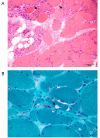Molecular diagnosis of hereditary inclusion body myopathy by linkage analysis and identification of a novel splice site mutation in GNE
- PMID: 21708040
- PMCID: PMC3141630
- DOI: 10.1186/1471-2350-12-87
Molecular diagnosis of hereditary inclusion body myopathy by linkage analysis and identification of a novel splice site mutation in GNE
Abstract
Background: Many myopathies share clinical features in common, and diagnosis often requires genetic testing. We ascertained a family in which five siblings presented with distal muscle weakness of unknown etiology.
Methods: We performed high-density genomewide linkage analysis and mutation screening of candidate genes to identify the genetic defect in the family. Preserved clinical biopsy material was reviewed to confirm the diagnosis, and reverse transcriptase PCR was used to determine the molecular effect of a splice site mutation.
Results: The linkage scan excluded the majority of known myopathy genes, but one linkage peak included the gene GNE, in which mutations cause autosomal recessive hereditary inclusion body myopathy type 2 (HIBM2). Muscle biopsy tissue from a patient showed myopathic features, including small basophilic fibers with vacuoles. Sequence analysis of GNE revealed affected individuals were compound heterozygous for a novel mutation in the 5' splice donor site of intron 10 (c.1816+5G>A) and a previously reported missense mutation (c.2086G>A, p.V696M), confirming the diagnosis as HIBM2. The splice site mutation correlated with exclusion of exon 10 from the transcript, which is predicted to produce an in-frame deletion (p.G545_D605del) of 61 amino acids in the kinase domain of the GNE protein. The father of the proband was heterozygous for the splice site mutation and exhibited mild distal weakness late in life.
Conclusions: Our study expands on the extensive allelic heterogeneity of HIBM2 and demonstrates the value of linkage analysis in resolving ambiguous clinical findings to achieve a molecular diagnosis.
Figures



Similar articles
-
Novel GNE mutations in two phenotypically distinct HIBM2 patients.Neuromuscul Disord. 2011 Feb;21(2):102-5. doi: 10.1016/j.nmd.2010.11.002. Epub 2010 Dec 4. Neuromuscul Disord. 2011. PMID: 21131200 Free PMC article.
-
Clinical features, lectin staining, and a novel GNE frameshift mutation in hereditary inclusion body myopathy.Clin Neuropathol. 2010 Mar-Apr;29(2):71-7. Clin Neuropathol. 2010. PMID: 20175955 Free PMC article.
-
Clinical and genetic heterogeneity in chromosome 9p associated hereditary inclusion body myopathy: exclusion of GNE and three other candidate genes.Neuromuscul Disord. 2003 Sep;13(7-8):559-67. doi: 10.1016/s0960-8966(03)00070-1. Neuromuscul Disord. 2003. PMID: 12921793
-
Hereditary inclusion-body myopathy with sparing of the quadriceps: the many tiles of an incomplete puzzle.Acta Myol. 2011 Oct;30(2):91-5. Acta Myol. 2011. PMID: 22106710 Free PMC article. Review.
-
Hereditary inclusion body myopathy: a decade of progress.Biochim Biophys Acta. 2009 Sep;1792(9):881-7. doi: 10.1016/j.bbadis.2009.07.001. Epub 2009 Jul 24. Biochim Biophys Acta. 2009. PMID: 19596068 Free PMC article. Review.
Cited by
-
Revisiting the immunopathology of congenital disorders of glycosylation: an updated review.Front Immunol. 2024 Mar 14;15:1350101. doi: 10.3389/fimmu.2024.1350101. eCollection 2024. Front Immunol. 2024. PMID: 38550576 Free PMC article. Review.
-
Inclusion body myositis - pathomechanism and lessons from genetics.Open Med (Wars). 2015 Feb 26;10(1):188-193. doi: 10.1515/med-2015-0030. eCollection 2015. Open Med (Wars). 2015. PMID: 28352694 Free PMC article. Review.
-
Analysis of the pathogenicity of novel GNE mutations and clinical, pathological, and genetic characteristics of GNE myopathy in Chinese population.Orphanet J Rare Dis. 2025 Apr 5;20(1):161. doi: 10.1186/s13023-025-03696-2. Orphanet J Rare Dis. 2025. PMID: 40188109 Free PMC article.
-
Quantitative nuclear magnetic resonance imaging detects subclinical changes over 1 year in skeletal muscle of GNE myopathy.J Neurol. 2020 Jan;267(1):228-238. doi: 10.1007/s00415-019-09569-6. Epub 2019 Oct 15. J Neurol. 2020. PMID: 31616990
-
Phenotypic stratification and genotype-phenotype correlation in a heterogeneous, international cohort of GNE myopathy patients: First report from the GNE myopathy Disease Monitoring Program, registry portion.Neuromuscul Disord. 2018 Feb;28(2):158-168. doi: 10.1016/j.nmd.2017.11.001. Epub 2017 Nov 14. Neuromuscul Disord. 2018. PMID: 29305133 Free PMC article.
References
-
- Neudecker S, Krasnianski M, Bahn E, Zierz S. Rimmed vacuoles in facioscapulohumeral muscular dystrophy: a unique ultrastructural feature. Acta Neuropathol. 2004;108(3):257–259. - PubMed
-
- Hauser MA, Horrigan SK, Salmikangas P, Torian UM, Viles KD, Dancel R, Tim RW, Taivainen A, Bartoloni L, Gilchrist JM, Stajich JM, Gaskell PC, Gilbert JR, Vance JM, Pericak-Vance MA, Carpen O, Westbrook CA, Speer MC. Myotilin is mutated in limb girdle muscular dystrophy 1A. Hum Mol Genet. 2000;9(14):2141–2147. doi: 10.1093/hmg/9.14.2141. - DOI - PubMed
-
- Eisenberg I, Avidan N, Potikha T, Hochner H, Chen M, Olender T, Barash M, Shemesh M, Sadeh M, Grabov-Nardini G, Shmilevich I, Friedmann A, Karpati G, Bradley WG, Baumbach L, Lancet D, Asher EB, Beckmann JS, Argov Z, Mitrani-Rosenbaum S. The UDP-N-acetylglucosamine 2-epimerase/N-acetylmannosamine kinase gene is mutated in recessive hereditary inclusion body myopathy. Nat Genet. 2001;29(1):83–87. doi: 10.1038/ng718. - DOI - PubMed
Publication types
MeSH terms
Substances
Grants and funding
LinkOut - more resources
Full Text Sources

